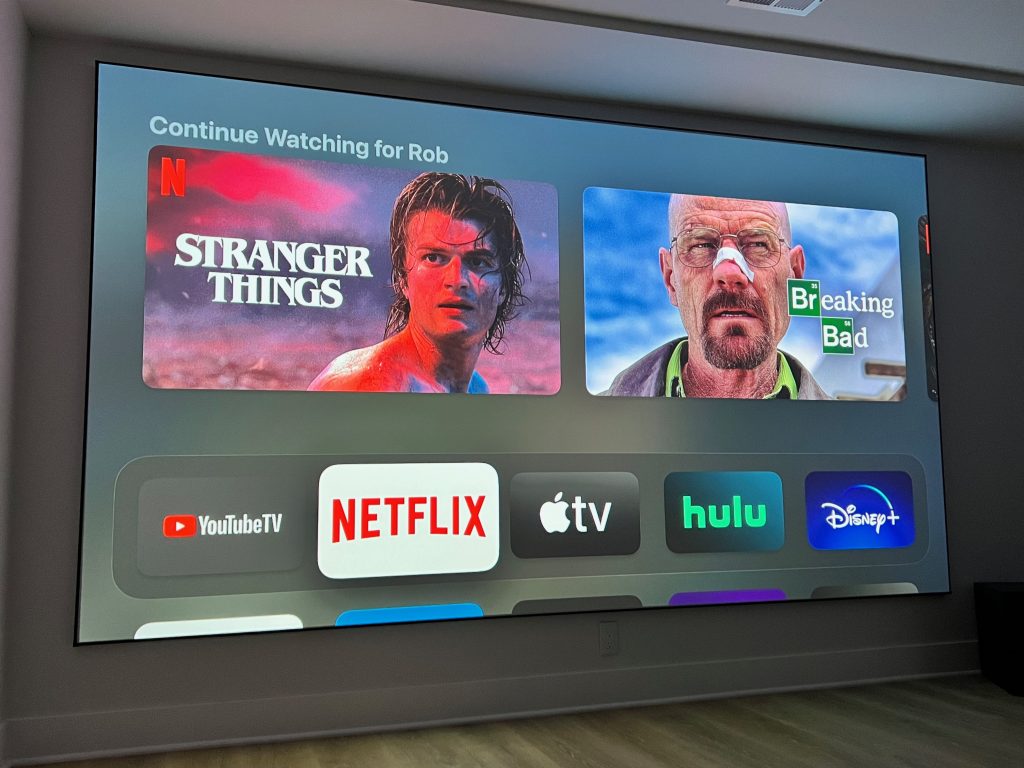When setting up a home theater or presentation space, one of the most common questions is: Do I really need a projector screen, or can I just use a wall? While projecting onto a wall might seem like a simple and cost-effective solution, the choice between a wall and a dedicated projector screen can significantly impact the quality of your viewing experience.

Key Differences Between Walls and Projector Screens
- Reflectivity and Gain
Projector screens are designed with specific reflectivity, or “gain,” that enhances image brightness and uniformity. A high-quality screen can reflect light more efficiently than a wall, ensuring vibrant and evenly lit images. Walls, even if painted white, lack the reflective coatings of screens, leading to duller visuals and uneven brightness. - Surface Uniformity
A projector screen is engineered to have a perfectly smooth surface. Walls, on the other hand, often have imperfections such as bumps, textures, or uneven paint. These flaws can distort the image, creating distractions that diminish the viewing experience. - Color Accuracy and Contrast
Screens are optimized for color fidelity and contrast. For example, gray screens can enhance black levels and contrast in environments with some ambient light, while ALR (Ambient Light Rejecting) screens improve image visibility in brighter rooms by selectively reflecting projector light while absorbing ambient light. Walls cannot offer these specialized benefits. - Viewing Angle and Brightness
A screen’s viewing angle determines how well an image maintains its brightness and quality when viewed from different positions in the room. High-quality screens with wide viewing cones ensure everyone sees a clear image, even if seated off-center. Walls, lacking these properties, may result in a diminished experience for viewers sitting at an angle.
When Might a Wall Be Enough?
In some cases, using a wall might suffice:
- Temporary setups: If you’re experimenting with a projector or setting up a short-term solution.
- Smooth, neutral-colored walls: If your wall is perfectly smooth and painted with projector-specific paint, you may achieve acceptable results.
- Low expectations: For casual viewing where image quality isn’t a priority, a wall might do.
Why a Projector Screen is Worth the Investment
If you’re serious about your home theater or presentation space, here’s why a screen is the better choice:
- Enhanced Visuals: The reflective and uniform surface of a screen ensures sharp, bright, and vibrant images, particularly with modern projectors capable of HDR (High Dynamic Range) and 4K resolution.
- Ambient Light Performance: Screens like ALR screens are designed to combat ambient light, ensuring clear visuals even in less-than-dark environments. Walls can’t selectively reject ambient light, leading to washed-out images.
- Customizable Options: Screens come in a variety of types—fixed-frame, retractable, tab-tensioned, and more—allowing you to tailor your setup to your space and needs.
- Precision Viewing: Features like half-gain measurements and optimized viewing angles ensure everyone in the room enjoys a consistent viewing experience, something a wall simply can’t guarantee.
- Professional Aesthetic: A well-mounted screen enhances the overall aesthetic and professionalism of your space, whereas a blank wall might feel less polished.
Conclusion: Wall vs. Screen
While projecting onto a wall might be convenient in certain situations, a projector screen is essential for anyone seeking a high-quality viewing experience. The investment in a screen pays off with sharper images, better color reproduction, and a professional appearance that a wall simply cannot match.
If you’re ready to take your projector setup to the next level, investing in a quality screen will transform how you enjoy movies, sports, or presentations. After all, a great projector deserves an equally great screen.
